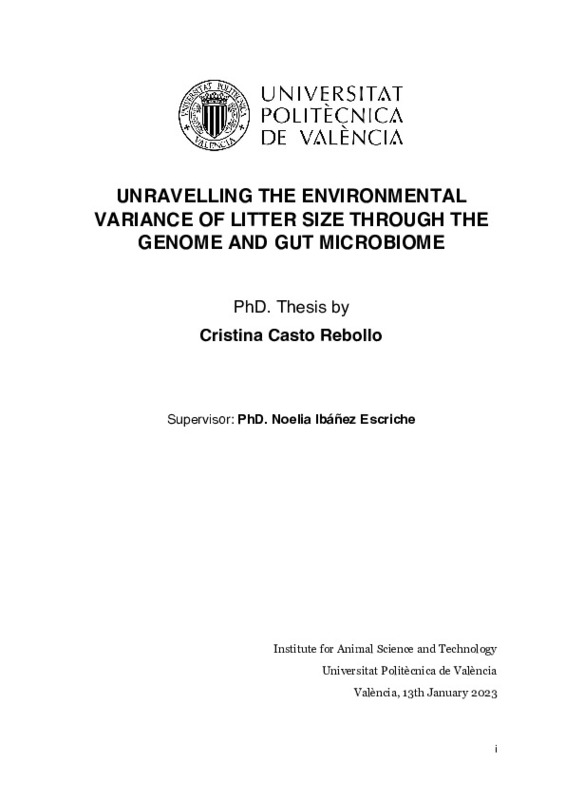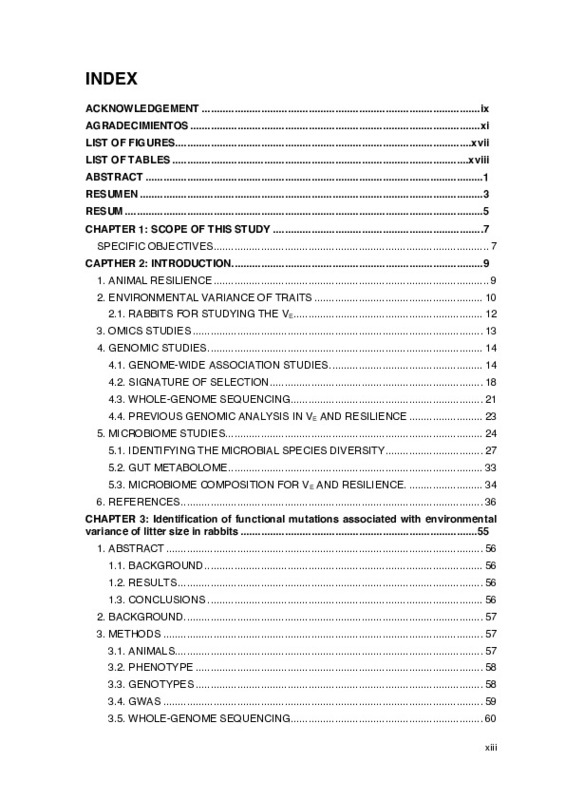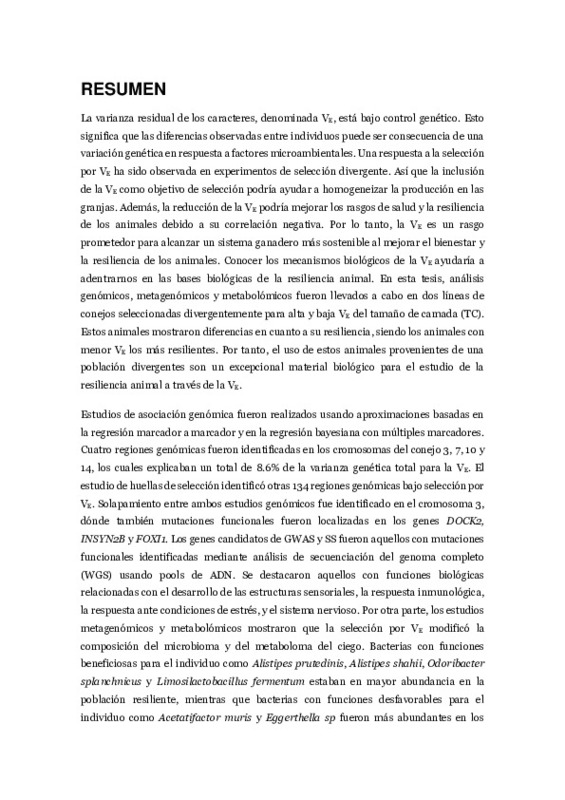- RiuNet repositorio UPV
- :
- Investigación
- :
- Tesis doctorales
- :
- Ver ítem
JavaScript is disabled for your browser. Some features of this site may not work without it.
Buscar en RiuNet
Listar
Mi cuenta
Estadísticas
Ayuda RiuNet
Admin. UPV
Unravelling the Environmental Variance of Litter Size Through the Genome and Gut Microbiome
Mostrar el registro sencillo del ítem
Ficheros en el ítem
| dc.contributor.advisor | Ibáñez Escriche, Noelia
|
es_ES |
| dc.contributor.author | Casto Rebollo, Cristina
|
es_ES |
| dc.date.accessioned | 2023-03-09T11:09:57Z | |
| dc.date.available | 2023-03-09T11:09:57Z | |
| dc.date.created | 2023-01-13 | |
| dc.date.issued | 2024-01-13 | es_ES |
| dc.identifier.uri | http://hdl.handle.net/10251/192460 | |
| dc.description.abstract | [ES] En esta tesis, se realizaron análisis genómicos, metagenómicos y metabolómicos en líneas de conejo seleccionadas de forma divergente para alta y baja VE del tamaño de la camada (TC). Estos animales mostraron diferencias en su potencial de resiliencia. Por ello, estas poblaciones divergentes son un excelente material biológico para estudiar la resiliencia animal a través de la VE. Se realizaron estudios de asociación del genoma (GWAS) utilizando la regresión de un solo marcador y la regresión bayesiana de múltiples marcadores. Cuatro regiones genómicas se asociaron con la VE en el cromosoma 3 de Oryctolagus cuniculus (OCU), OCU7, OCU10 y OCU14, explicando el 8,6% de la varianza genética total para la VE. Además, el estudio de huellas de selección (SS) identificó 134 regiones genómicas que podrían estar bajo selección para la VE. El solapamiento entre ambos estudios se identificó en el OCU3, donde también se encontraron mutaciones funcionales para los genes DOCK2, INSYN2B y FOXI1. Los genes candidatos de GWAS y SS fueron aquellos con mutaciones funcionales identificadas mediante el análisis de secuenciación del genoma completo (WGS) con pools de ADN. Los genes candidatos destacados mostraron funciones biológicas relacionadas con el desarrollo de estructuras sensoriales, la respuesta inmunitaria, la respuesta al estrés y el sistema nervioso. Todas ellas son funciones relevantes para modular la resiliencia de los animales. Por otra parte, los estudios metagenómicos y metabolómicos mostraron que la selección para la VE modificó el microbioma intestinal y la composición de su metaboloma. Las especies microbianas beneficiosas como Alistipes prutedinis, Alistipes shahii, Odoribacter splanchnicus y Limosilactobacillus fermentum eran más abundantes en la población resiliente. En cambio, las especies microbianas nocivas, como Acetatifactor muris y Eggerthella sp, fueron más abundantes en los animales no resistentes. Los genes relacionados con la formación de biofilms, el metabolismo de aminoácidos aromáticos (fenilalanina, triptófano y tirosina) y el metabolismo del glutamato también se expresaron de forma diferencial entre las poblaciones de conejos. Además, se identificaron 15 metabolitos intestinales como potenciales biomarcadores para discriminar y predecir adecuadamente entre las poblaciones de conejos resistentes y no resistentes. Cinco de ellos, el equol, el 3-(4-hidroxifenil)lactato, el 5-aminovalerato, la N6-acetilisina y la serina son metabolitos de origen microbiano. Este es el primer estudio que desvela importantes mecanismos biológicos de la resiliencia animal generada por la selección de la VE de TC. El genoma y el microbioma intestinal y la composición del metaboloma se modificaron a lo largo del proceso de selección, afectando a la respuesta inmunitaria y al estrés. Se encontraron resultados coincidentes entre los estudios metagenómicos y del metaboloma. Por otro lado, en esta tesis desarrollamos por primera vez una herramienta flexible para simular la coevolución del genoma y el microbioma a través de un proceso de selección. La clave de esta herramienta fue la implementación de la herencia del microbioma. Está construida en R y basada en AlphaSimR para que el usuario pueda modificar el código e implementar diferentes escenarios. Esta tesis es el primer paso para desarrollar futuras estrategias y nuevas investigaciones para mejorar la resiliencia de los animales. Una selección que combine información genómica y metagenómica puede mejorar la respuesta de selección. Además, los metabolitos derivados del intestino con evidencia de crosstalk pueden utilizarse como biomarcadores para identificar animales resilientes por plasma, evitando la extracción de muestras fecales para determinar la composición del microbioma. Si estos estudios tienen éxito, estas estrategias podrían mejorar la resiliencia de los animales con el objetivo de buscar un sistema ganadero más sostenible. | es_ES |
| dc.description.abstract | [CA] En aquesta tesi, es van realitzar anàlisis genòmiques, metagenòmiques i metabolòmiques en línies de conill seleccionades de manera divergent per a alta i baixa VE de la grandària de la ventrada (GV). Aquests animals van mostrar diferències en el seu potencial de resiliència. Per això, aquestes poblacions divergents són un excel·lent material biològic per a estudiar la resiliència animal a través de la VE. Es van realitzar estudis d'associació del genoma (GWAS) utilitzant la regressió d'un solo marcador i la regressió bayesiana de múltiples marcadors. Quatre regions genòmiques es van associar amb la VE en el cromosoma 3 de Oryctolagus cuniculus (OCU), OCU7, OCU10 i OCU14, explicant el 8,6% de la variància genètica total per a la VE. A més, l'estudi de petjades de selecció (SS) va identificar 134 regions genòmiques que podrien estar sota selecció per a la VE. El solapament entre tots dos estudis es va identificar en l'OCU3, on també es van trobar mutacions funcionals per als gens DOCK2, INSYN2B i FOXI1. Els gens candidats de GWAS i SS van ser aquells amb mutacions funcionals identificades mitjançant l'anàlisi de seqüenciació del genoma complet (WGS) amb pools d'ADN. Els gens candidats destacats van mostrar funcions biològiques relacionades amb el desenvolupament d'estructures sensorials, la resposta immunitària, la resposta a l'estrés i el sistema nerviós. Totes elles són funcions rellevants per a modular la resiliència dels animals. D'altra banda, els estudis metagenòmiques i *metabolòmiques van mostrar que la selecció per a la VE va modificar el microbioma intestinal i la composició de la seua metaboloma. Les espècies microbianes beneficioses com Alistipes prutedinis, Alistipes shahii, Odoribacter splanchnicus i Limosilactobacillus fermentum eren més abundants en la població resilient. En canvi, les espècies microbianes nocives, com Acetatifactor muris i Eggerthella sp, van ser més abundants en els animals no resistents. Els gens relacionats amb la formació de biofilms, el metabolisme d'aminoàcids aromàtics (fenilalanina, triptòfan i tirosina) i el metabolisme del glutamat també es van expressar de manera diferencial entre les poblacions de conills. A més, es van identificar 15 metabòlits intestinals com a potencials biomarcadores per a discriminar i predir adequadament entre les poblacions de conills resistents i no resistents. Cinc d'ells, el equol, el 3-(4-hidroxifenil)lactat, el 5-aminovalerato, la N6-acetilisina i la serina són metabòlits d'origen microbià. Aquest és el primer estudi que revela importants mecanismes biològics de la resiliència animal generada per la selecció de la VE de GC. El genoma i el microbioma intestinal i la composició del metaboloma es van modificar al llarg del procés de selecció, afectant la resposta immunitària i a l'estrés. Es van trobar resultats coincidents entre els estudis metagenòmiques i del metaboloma. D'altra banda, en aquesta tesi desenvolupem per primera vegada una eina flexible per a simular la coevolució del genoma i el microbioma a través d'un procés de selecció. La clau d'aquesta eina va ser la implementació de l'herència del microbioma. Està construïda en R i basada en AlphaSimR perquè l'usuari puga modificar el codi i implementar diferents escenaris. Aquesta tesi és el primer pas per a desenvolupar futures estratègies i noves investigacions per a millorar la resiliència dels animals. Una selecció que combine informació genòmica i metagenòmique pot millorar la resposta de selecció. A més, els metabòlits derivats de l'intestí amb evidència de crosstalk poden utilitzar-se com biomarcadores per a identificar animals resilients per plasma, evitant l'extracció de mostres fecals per a determinar la composició del microbioma. Si aquests estudis tenen èxit, aquestes estratègies podrien millorar la resiliència dels animals amb l'objectiu de buscar un sistema ramader més sostenible. | es_ES |
| dc.description.abstract | [EN] Disclosing the biological mechanisms of the VE can help to gain some insight into the biological basics of animal resilience. In this thesis, genomic, metagenomic, and metabolomic analyses were performed on rabbit lines divergently selected for high and low VE of litter size (LS). These animals showed differences in their resilience potential. Thus, these divergent populations are an excellent biological material for studying animal resilience through the VE. Genome-wide association studies (GWAS) were performed using single marker regression, and Bayesian multiple marker regression approaches. Four genomic regions were associated with the VE in the Oryctolagus cuniculus chromosome (OCU) 3, OCU7, OCU10, and OCU14, explaining 8.6% of the total genetic variance for the VE. In addition, the signature of selection (SS) study identified 134 genomic regions which could be under selection for VE. Overlapping between both studies was placed in the OCU3, where functional mutations for the DOCK2, INSYN2B and FOXI1 genes were also found. Candidate genes from GWAS and SS were those with functional mutations identified using whole genome sequencing (WGS) analysis with pools of DNA. Highlighted candidate genes showed biological functions related to the development of sensory structures, the immune response, the stress response, and the nervous system. All of them are relevant functions to modulate animal resilience. On the other hand, metagenomic and metabolomic studies showed that the selection for VE modified the gut microbiome and metabolome composition. Beneficial microbial species such as Alistipes prutedinis, Alistipes shahii, Odoribacter splanchnicus and Limosilactobacillus fermentum were more abundant in the resilient population. In contrast, harmful microbial species such as Acetatifactor muris and Eggerthella sp were more abundant in the non-resilient animals. Genes related to biofilm formation, aromatic amino acid metabolism (Phenylalanine, tryptophan, and tyrosine), and glutamate metabolism were also differentially expressed between the rabbit populations. Furthermore, 15 gut metabolites were identified as potential biomarkers to properly discriminate and predict between the resilient and non-resilient rabbit populations. Five of them, the equol, 3-(4-hydroxyphenyl)lactate, 5-aminovalerate, N6-acetyllisine, and serine were microbial-derived metabolites. This is the first study unravelling important biological mechanisms under the animal resilience generated by VE of LS selection. Genome and gut microbiome and metabolome composition were modified throughout the selection process, affecting the immune and stress response. Overlapping results were found between the metagenomic and metabolome studies. On the other hand, in this thesis, we developed a flexible tool for simulating the coevolution of the genome and microbiome across a selection process for the first time. The key of this tool was the implementation of the microbiome inheritance. It is constructed in R and based on AlphaSimR so the user can modify the code and implement different scenarios. This thesis is the first step to develop future strategies and further research to improve animal resilience. A selection combining genomic and metagenomic information may improve the selection response. Moreover, gut-derived metabolites with evidence of crosstalk can be used as biomarkers to identify resilient animals by plasma, avoiding the extraction of faecal samples to determine the microbiome composition. If these studies suceed, these strategies could improve animal resilience with the aim of search a more sustainable livestock system. Lastly, the simulation tool developed could help unravel the microbiome's implications in animal breeding programs. | es_ES |
| dc.description.sponsorship | This study was supported by projects AGL2014-5592, C2-1-P and C2-2-P, and AGL2017-86083, C2-1-P and C2-2-P, funded by the Spanish Ministerio de Ciencia e Innovación (MIC)-Agencia Estatal de Investigación (AEI) and the European Regional Development Fund (FEDER). Projects PID2020-115558GB-C21, funded by the Spanish Ministerio de Ciencia e Innovación (MIC)-Agencia Estatal de Investigación (AEI) and the European Regional Development Funds (FEDER) FPU17/01196 scholarship from the Spanish Ministry of Science, Innovation and Universities. | es_ES |
| dc.format.extent | 173 | es_ES |
| dc.language | Inglés | es_ES |
| dc.publisher | Universitat Politècnica de València | es_ES |
| dc.rights | Reserva de todos los derechos | es_ES |
| dc.subject | Resistencia animal | es_ES |
| dc.subject | Varianza ambiental | es_ES |
| dc.subject | Genoma | es_ES |
| dc.subject | Microbioma intestinal | es_ES |
| dc.subject | Conejos | es_ES |
| dc.subject | Environmental variance | es_ES |
| dc.subject | Animal resilience | es_ES |
| dc.subject | Genome | es_ES |
| dc.subject | Gut microbiome | es_ES |
| dc.subject | Rabbit | es_ES |
| dc.subject.classification | PRODUCCION ANIMAL | es_ES |
| dc.title | Unravelling the Environmental Variance of Litter Size Through the Genome and Gut Microbiome | es_ES |
| dc.type | Tesis doctoral | es_ES |
| dc.identifier.doi | 10.4995/Thesis/10251/192460 | es_ES |
| dc.relation.projectID | info:eu-repo/grantAgreement/MICIU//FPU17%2F01196//AYUDA CONTRATO PREDOCTORAL FPU-CASTO REBOLLO/ | es_ES |
| dc.relation.projectID | info:eu-repo/grantAgreement/AEI/Plan Estatal de Investigación Científica y Técnica y de Innovación 2017-2020/PID2020-115558GB-C21/ES/CREACION DE DOS LINEAS SELECCIONADAS POR EFICIENCIA ALIMENTARIA Y POR RESILIENCIA/ | es_ES |
| dc.relation.projectID | info:eu-repo/grantAgreement/AEI/Plan Estatal de Investigación Científica y Técnica y de Innovación 2013-2016/AGL2017-86083-C2-2-P/ES/ESTUDIO MULTIOMICO DE LA MICROBIOTA DIGESTIVA Y SU RELACION CON LA SENSIBILIDAD AL AMBIENTE EN LINEAS DE CONEJO SELECCIONADAS POR VARIABILIDAD AMBIENTAL/ | es_ES |
| dc.relation.projectID | info:eu-repo/grantAgreement/AEI/Plan Estatal de Investigación Científica y Técnica y de Innovación 2013-2016/AGL2017-86083-C2-1-P/ES/ESTUDIO MULTIOMICO SOBRE SENSIBILIDAD AMBIENTAL, LONGEVIDAD Y DEPOSICION GRASA EN LINEAS SELECCIONADAS DE CONEJO/ | es_ES |
| dc.relation.projectID | info:eu-repo/grantAgreement/MINECO//AGL2014-55921-C2-2-P/ES/ANALISIS GENOMICO DE LA VARIANZA RESIDUAL DEL TAMAÑO DE CAMADA Y SU RELACION CON EL BIENESTAR ANIMAL/ | es_ES |
| dc.relation.projectID | info:eu-repo/grantAgreement/MINECO//AGL2014-55921-C2-1-P/ES/ESTUDIO GENOMICO Y METABOLOMICO DE VARIAS LINEAS DE SELECCION DIVERGENTE EN CONEJO: EL CONEJO COMO MODELO EXPERIMENTAL/ | es_ES |
| dc.rights.accessRights | Abierto | es_ES |
| dc.contributor.affiliation | Universitat Politècnica de València. Departamento de Ciencia Animal - Departament de Ciència Animal | es_ES |
| dc.description.bibliographicCitation | Casto Rebollo, C. (2023). Unravelling the Environmental Variance of Litter Size Through the Genome and Gut Microbiome [Tesis doctoral]. Universitat Politècnica de València. https://doi.org/10.4995/Thesis/10251/192460 | es_ES |
| dc.description.accrualMethod | TESIS | es_ES |
| dc.type.version | info:eu-repo/semantics/acceptedVersion | es_ES |
| dc.relation.pasarela | TESIS\13147 | es_ES |
| dc.contributor.funder | Ministerio de Ciencia, Innovación y Universidades | es_ES |
| dc.contributor.funder | Agencia Estatal de Investigación | es_ES |
| dc.contributor.funder | Ministerio de Economía y Competitividad | es_ES |
Este ítem aparece en la(s) siguiente(s) colección(ones)
-
Tesis doctorales [5389]










